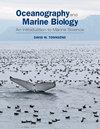The humboldt current system of northern and central chile : Oceanographic processes, ecological interactions and socioeconomic feedback
1区 生物学
Q1 Agricultural and Biological Sciences
引用次数: 489
Abstract
The Humboldt Current System (HCS) is one of the most productive marine ecosystems on earth. It extends along the west coast of South America from southern Chile (∼42°S) up to Ecuador and the Galapagos Islands near the equator. The general oceanography of the HCS is characterised by a predominant northward flow of surface waters of subantarctic origin and by strong upwelling of cool nutrient-rich subsurface waters of equatorial origin. Along the coast of northern and central Chile, upwelling is localised and its occurrence changes from being mostly continuous (aseasonal) in northern Chile to a more seasonal pattern in southern-central Chile. Several important upwelling centres along the Chilean coast are interspersed with long stretches of coast without or with sporadic and less intense upwelling. Large-scale climatic phenomena (El Nino Southern Oscillation, ENSO) are superimposed onto this regional pattern, which results in a high spatiotemporal heterogeneity, complicating the prediction of ecological processes along the Chilean coast. This limited predictability becomes particularly critical in light of increasing human activities during the past decades, at present mainly in the form of exploitation of renewable resources (fish, invertebrates and macroalgae). This review examines current knowledge of ecological processes in the HCS of northern and central Chile, with a particular focus on oceanographic factors and the influence of human activities, and further suggests conservation strategies for this high-priority large marine ecosystem. Along the Chilean coast, the injection of nutrients into surface waters through upwelling events results in extremely high primary production. This fuels zooplankton and fish production over extensive areas, which also supports higher trophic levels, including large populations of seabirds and marine mammals. Pelagic fisheries, typically concentrated near main upwelling centres (20-22°S, 32-34°S, 36-38°S), take an important share of the fish production, thereby affecting trophic interactions in the HCS. Interestingly, El Nino (EN) events in northern Chile do not appear to cause a dramatic decline in primary or zooplankton production but rather a shift in species composition, which affects trophic efficiency of and interactions among higher-level consumers. The low oxygen concentrations in subsurface waters of the HCS (oxygen-minimum zone, OMZ) influence predator-prey interactions in the plankton by preventing some species from migrating to deeper waters. The OMZ also has a strong effect on the bathymetric distribution of sublittoral soft-bottom communities along the Chilean coast. The few long-term studies available from sublittoral soft-bottom communities in northern and central Chile suggest that temporal dynamics in abundance and community composition are driven by interannual phenomena (EN and the extent and intensity of the OMZ) rather than by intra-annual (seasonal) patterns. Macrobenthic communities within the OMZ are often dominated in biomass by sulphide-oxidising, mat-forming bacteria. Though the contribution of these microbial communities to the total primary production of the system and their function in structuring OMZ communities is still scarcely known, they presumably play a key role, also in sustaining large populations of economically valuable crustaceans.智利北部和中部洪堡洋流系统:海洋学过程、生态相互作用和社会经济反馈
洪堡洋流系统(HCS)是地球上最具生产力的海洋生态系统之一。它沿着南美洲西海岸从智利南部(~ 42°S)一直延伸到厄瓜多尔和赤道附近的加拉帕戈斯群岛。HCS的一般海洋学特征是亚南极来源的地表水主要向北流动,而赤道来源的冷的富含营养的地下水则有强烈的上升流。沿智利北部和中部海岸,上升流是局部的,其发生变化从智利北部的大部分连续(季节性)到智利中南部的季节性模式。沿着智利海岸的几个重要的上升流中心散布在没有或有零星的和不太强烈的上升流的海岸线上。大尺度气候现象(厄尔尼诺-南方涛动,ENSO)叠加在这一区域格局上,导致了高度的时空异质性,使智利沿海生态过程的预测复杂化。鉴于过去几十年人类活动增加,目前主要是开发可再生资源(鱼类、无脊椎动物和大型藻类),这种有限的可预测性变得特别重要。本综述审查了目前对智利北部和中部高海拔地区生态过程的了解,特别关注海洋因素和人类活动的影响,并进一步提出了这一高度优先的大型海洋生态系统的保护战略。沿着智利海岸,通过上升流事件将营养物质注入地表水,导致了极高的初级产量。这促进了大面积浮游动物和鱼类的生产,也支持了更高的营养水平,包括大量的海鸟和海洋哺乳动物。中上层渔业通常集中在主要上升流中心(20-22°S, 32-34°S, 36-38°S)附近,在鱼类生产中占有重要份额,从而影响了HCS的营养相互作用。有趣的是,在智利北部发生的厄尔尼诺现象似乎并没有导致初级浮游动物或浮游动物产量的急剧下降,而是导致了物种组成的转变,这影响了更高层次消费者的营养效率和相互作用。HCS(氧气最低带,OMZ)的地下水低氧浓度通过阻止某些物种迁移到更深的水域来影响浮游生物的捕食者-猎物相互作用。OMZ对沿智利海岸的浅海软底群落的水深分布也有很强的影响。对智利北部和中部沿海软底群落进行的为数不多的长期研究表明,丰度和群落组成的时间动态是由年际现象(EN和OMZ的范围和强度)驱动的,而不是由年内(季节)模式驱动的。OMZ内的大型底栖生物群落在生物量上通常由硫化物氧化、席状形成的细菌主导。虽然这些微生物群落对整个系统初级生产的贡献及其在构建OMZ群落中的功能仍然知之甚少,但它们可能在维持大量具有经济价值的甲壳类动物种群方面发挥了关键作用。
本文章由计算机程序翻译,如有差异,请以英文原文为准。
求助全文
约1分钟内获得全文
求助全文
来源期刊
自引率
0.00%
发文量
0
期刊介绍:
With increasing interest in the field and its relevance in global environmental issues, Oceanography and Marine Biology: An Annual Review provides authoritative reviews that summarize results of recent research in basic areas of marine research, exploring topics of special and topical importance while adding to new areas as they arise

 求助内容:
求助内容: 应助结果提醒方式:
应助结果提醒方式:


